
by: SEO Strategist
Ashot Nanayan
Ashot Nanayan is the CEO and Founder of DWI and a seasoned SEO strategist. With a proven track record of...
All Articles by Ashot Nanayan
June 30, 2025
5 min. read
Ahrefs is one of my go-to SEO tools. I’ve been using it for over six years and haven’t betrayed my beloved tool, even when technical issues pop up a few times a month, or when they made it way more expensive and cut back on the unlimited credits. Anyone who’s been on the same journey with Ahrefs knows things aren’t perfect, and no SEO specialist should be relying too heavily on those third-party numbers anyway.
However, I couldn’t help but notice that a lot of beginners, business owners, and even SEO companies keep prioritizing their keywords based only on Ahrefs KD, then sit around for months or even years, hoping their zero-KD terms suddenly jump to the top.
Today, I want to share my experience from several years in the field to explain how Ahrefs measures keyword difficulty, when you should take it into account, and when you shouldn’t, and give you real ways to assess your chances of ranking at the top. Interesting, right? So hold on tight, today you’re finally getting those long-awaited answers.
Ahrefs Keyword Difficulty (KD) shows how hard it might be to rank on the first page of Google for a specific keyword. It’s a score from 0 to 100. The higher the number, the more competition you’ll face.
Here’s a column table breaking down Ahrefs Keyword Difficulty (KD) score ranges, what they mean, and how to approach them:
| KD Range | Competition Level | What It Means | Suggested Strategy |
|---|---|---|---|
| 0–10 | Very Low | Easy to rank with minimal backlinks | Target for new sites or low-authority pages |
| 11–30 | Low to Moderate | Requires some backlinks and solid content | Good for growing sites with basic SEO foundation |
| 31–70 | Moderate to High | Competitive; top pages have strong link profiles | Needs link building, strong content, and topical authority |
| 71–100 | Very high | Dominated by authoritative domains | Target selectively; build authority before going after these |
Ahrefs calculates this by checking how many backlinks the top-ranking pages already have. For example, in this case (check the screenshot below), it says I need over 400 referring domains to rank in the top 10 for the keyword “SEO agency”.

Now, based on the data, I can conclude that the term “SEO agency” is very competitive (which makes sense), but it doesn’t tell me much beyond that.
I mean, it does not guarantee that if I earn or buy over 400 backlinks (from unique referring domains), I’ll rank in the top 10, because, first of all, Ahrefs doesn’t say anything about backlink quality, average DR score, organic traffic, relevance, backlink type (editorial, sponsored, forums, etc.), and so on.
Next, apart from backlinks, search engines (especially Google) consider all kinds of stuff like Google E.E.A.T., content quality, UX, technical SEO, overall topical authority, and whatever else I didn’t mention (but yeah, they’ve probably covered it in their RankBrain system).
If someone from the Ahrefs team reads this guide, they’d probably agree I’m not trying to confuse anyone; my main goal is to help companies avoid spending a big portion of their SEO budget on content that’ll take forever to deliver the ROI they’re hoping for.
I mean, Ahrefs shows that a keyword is “hard to rank for,” but it doesn’t explain who it’s hard for. Is it hard for a brand-new site? A big authority site? A niche blog? That part is missing. Ahrefs KD is just a number, not personalized to your situation.
I’ll give you a simple example.
A website entirely about carnivorous plants, publishing original research, tutorials, care guides, and user-submitted experiments, can absolutely outrank a general gardening blog or a big lifestyle site if the query is “how to grow a Venus flytrap from seed.”
It doesn’t matter if the other site has a DR of 90 and this one has a DR of 18. Topical depth crushes broad authority if the content aligns tightly with search intent.
Do you know what happened with Forbes in late 2024?

For a long time, big websites like Forbes were getting easy traffic just because they were well-known. They wrote about almost anything, including tech topics, diet pills, VPNs, and more, mostly to generate income through affiliate links.
Even if the content wasn’t that good, they still ranked high in Google just because of their name.
But in September, Google finally shut it down after releasing the Helpful Content Update. “We’re done rewarding sites that abuse their authority to push weak, off-topic content.”
Forbes wasn’t the only one hit, but they were one of the biggest names to feel it publicly.
That’s why I always say: you can’t fake relevance forever. Authority might get you in the door, but topical depth and user-first content are what keep you in the room.
Okay, so as I said, KD isn’t the last metric I’d rely on, but there are some cases where I do take it into account.
For example, I consider KD when I’m conducting bulk keyword research and want to filter quickly. I don’t use it to decide which keywords to target. I just use it to save time. Like if I export 5,000 keywords, I’ll quickly filter out anything above 70 just to remove the obvious high-authority stuff.
Then I go through those filtered results one by one and manually check the SERPs. I see who’s ranking, pay attention to content depth, type, etc, and look for gaps.
Remember, low KD doesn’t always mean low competition, but high KD almost always means tough competition. Instead of wasting time on impossible targets, better focus on those that might work.
Sometimes you’ll spot a keyword with an Ahrefs KD of 0-10 and think, “Great, easy win.” A quick look at the SERP even supports your assumption: a couple of sites with a DR under 10 are sitting comfortably in the top ten.
But look closer and you’ll notice those tiny sites use exact-match domains, something like ladentalclinic.com.com ranking for “Dental clinic Los Angeles.”

Here is another example: very niche-specific keywords like “how to use Python for NLP and semantic SEO” often have low keyword difficulty scores, and in most cases, that’s accurate. The reason is simple: there aren’t many high-quality results on Google for such specialized topics, mainly because only a few people have the expertise to cover them well.
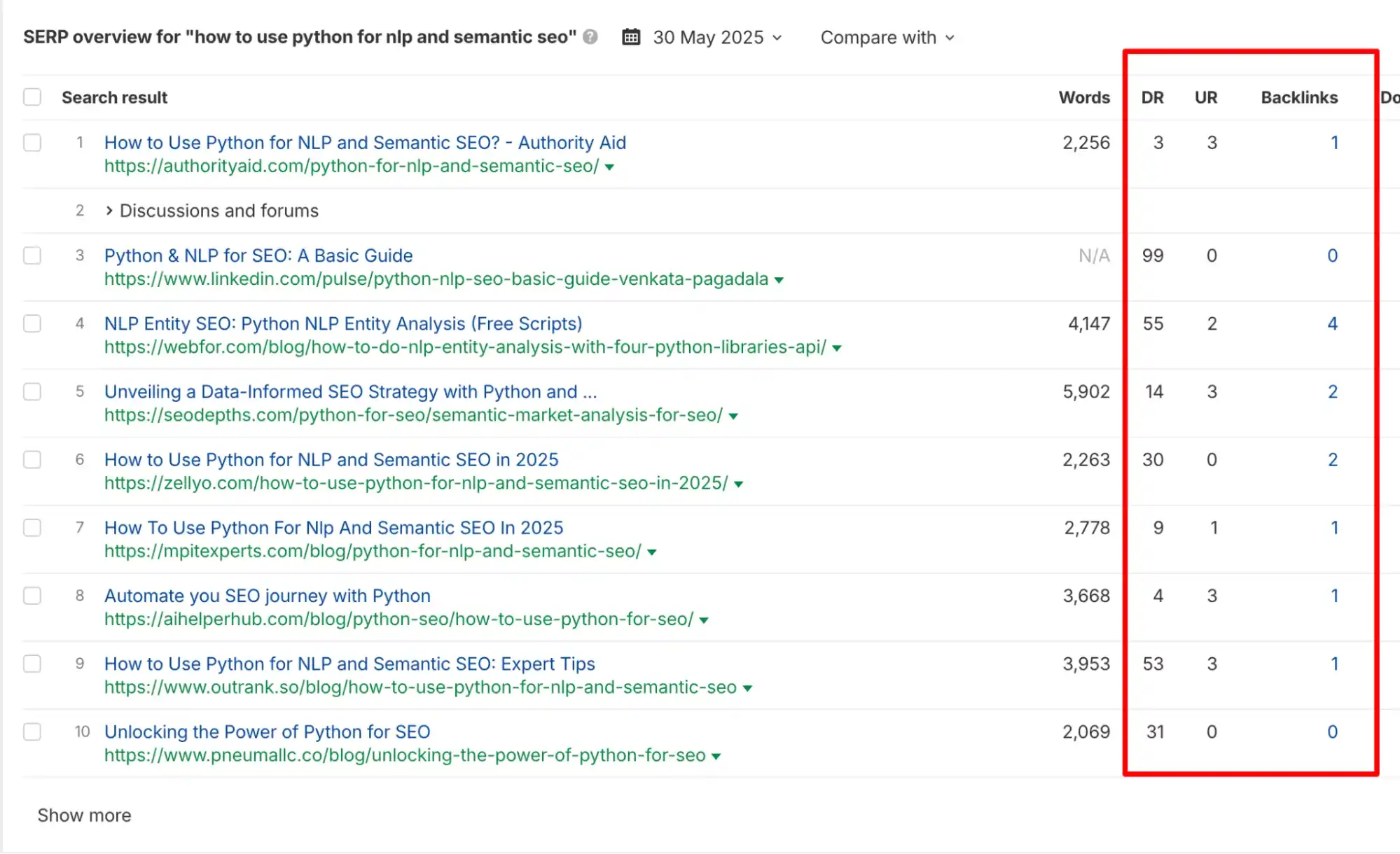
That said, it’s also important to note that these types of keywords usually fall under the TOFU (Top of the Funnel) category. They’re great for attracting an informed audience early in their research journey, but may not convert directly into sales or leads.
Next, KD scores can also be more accurate in non-English speaking countries, like Armenia, where general SEO awareness is still developing. In markets where many people aren’t familiar with concepts like backlinks or high-quality content, the competition is naturally lower.
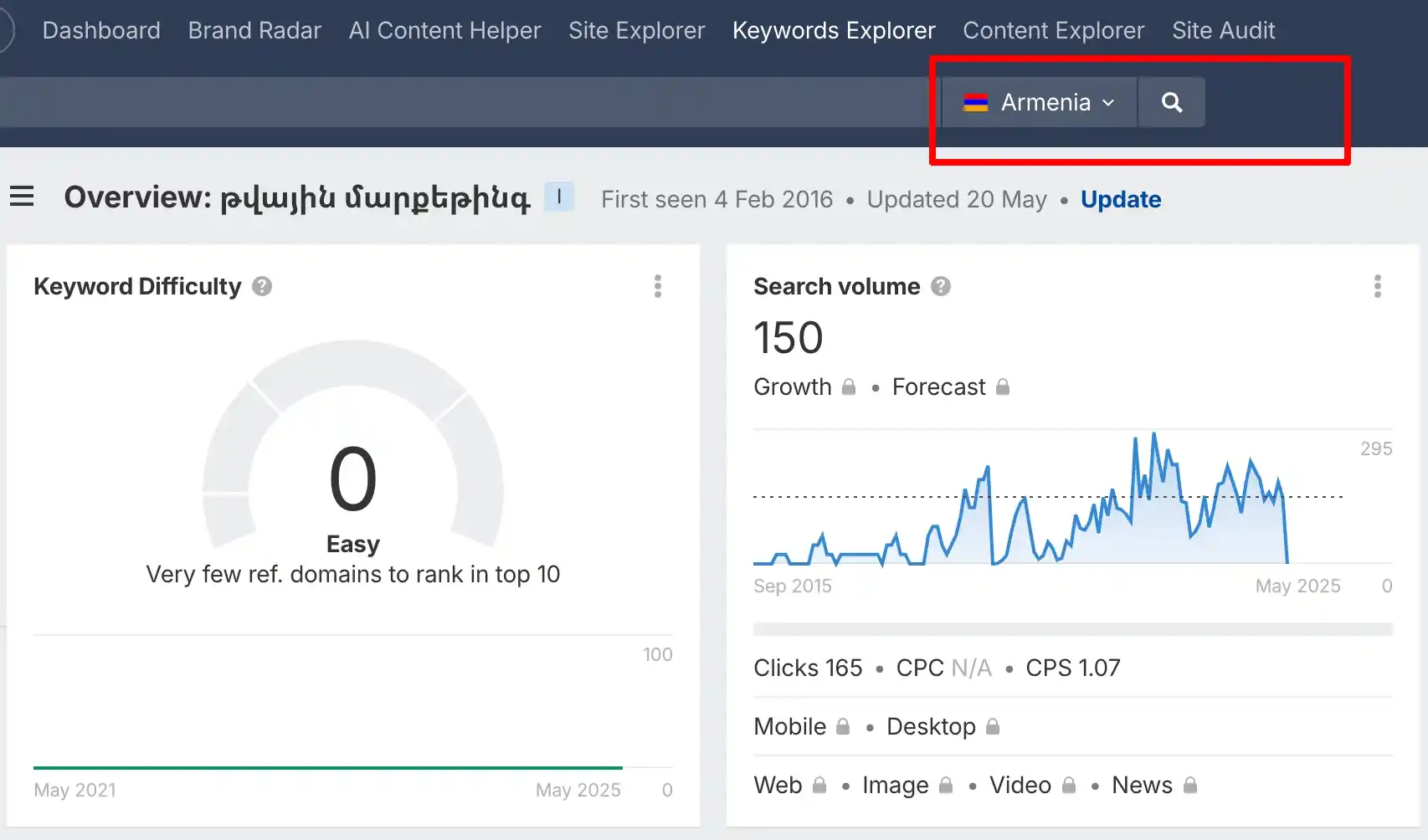
So if you choose the right keyword, it’s entirely possible to rank without backlinks within just a few days, even without a strong domain authority.
I also noticed that, in many cases, when you see a high keyword difficulty score but notice a low-authority website ranking in the top 10 or even the top 5, it’s often temporary. These sites can lose their positions within days or even hours, especially if stronger domains are also targeting the same keyword.
Finally, considering Digital World Institute’s case, I can confidently say that even if you can create the most valuable content and target a keyword with 0 KD, if your website is new and hasn’t earned Google’s trust yet, don’t expect instant results. In many cases, it can take at least 6 months before you start seeing any meaningful rankings, even for low-competition terms.
After years of working with all three SEO tools, I can confidently say that each platform presents keyword difficulty slightly differently; however, they all try to answer the same question: how hard will it be to rank?
I believe none of these scores can replace a manual SERP review. I mean, you still need to look at who’s ranking, the type of content, backlink profiles, and intent, because the number may guide your initial decisions, but it won’t tell the full story.
Below is a comprehensive overview
| Tool | KD Score Basis | Scale | How to Interpret It |
|---|---|---|---|
| Ahrefs | Based on the number of referring domains to top 10 pages | 0-100 | Higher KD = More backlinks needed to rank |
| SEMrush | Mix of backlink profile, domain strength, and SERP features | 0-100 | Higher KD = More competitive and requires both links + content |
| Moz | Page Authority and linking root domains to top results | 0-100 | Higher KD = Strong domains in top positions |
That said, SEMrush sets more realistic expectations. Its difficulty model takes into account a broader set of competitive signals across the SERP, such as domain strength, backlinks, and other page-level factors. It’s not perfect, but it mirrors how an SEO consultant or strategist would manually assess competition better than the others.
In contrast, Moz takes a broader approach. Its score is 95% influenced by domain authority (DA), which relies on backlink metrics.
I’ve been crafting many successful SEO campaigns for various business models and sectors, from eCommerce stores to B2B and SaaS. I don’t know about others, but my number one advantage is working without relying too much on AI.
So, if you really want to understand your chances of ranking, forget about Ahrefs KD for a second and just look at the SERP with your own eyes.
Let’s say I want to target the keyword “Fractional SEO consultant.” What would be my steps? Let’s see together.
First of all, I would open the top 20 URLs (Page-level competitors) to check if the top-ranking pages are from massive brands or smaller niche sites (Maybe even Reddit threads or Quora answers).
I would skip the pages that contain exact match domains (I already covered the reasons above).
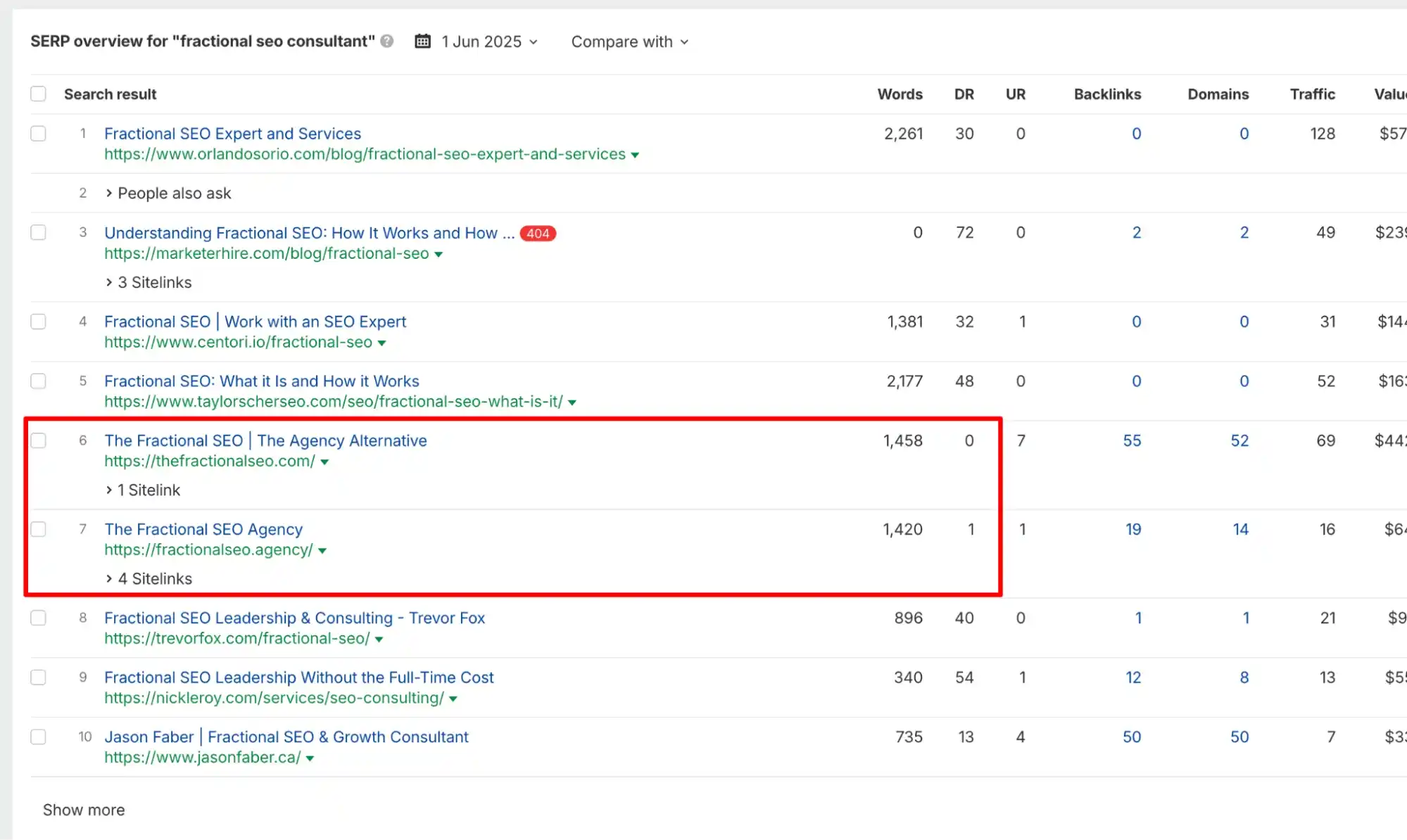
Next, I would analyze the following points:
I wouldn’t pay too much attention to their page-level referring domains, because in 90% of cases, keywords rank based on domain authority anyway.
If the content is thin, there are a lot of gaps, and I’m not competing with industry giants, that’s a green light.
On the other hand, if you’re trying to analyze your ranking potential for commercial keywords (where you can’t really evaluate content quality or anything like that), there’s a proven trick with Ahrefs you can try.
Add the seed keyword to Ahrefs’s Keyword Explorer (e.g., “cigars”). Then, filter for keywords where, in the top 5 or 10 SERP positions, there’s at least one domain with a DR that’s within your preferred range (e.g., up to 10).
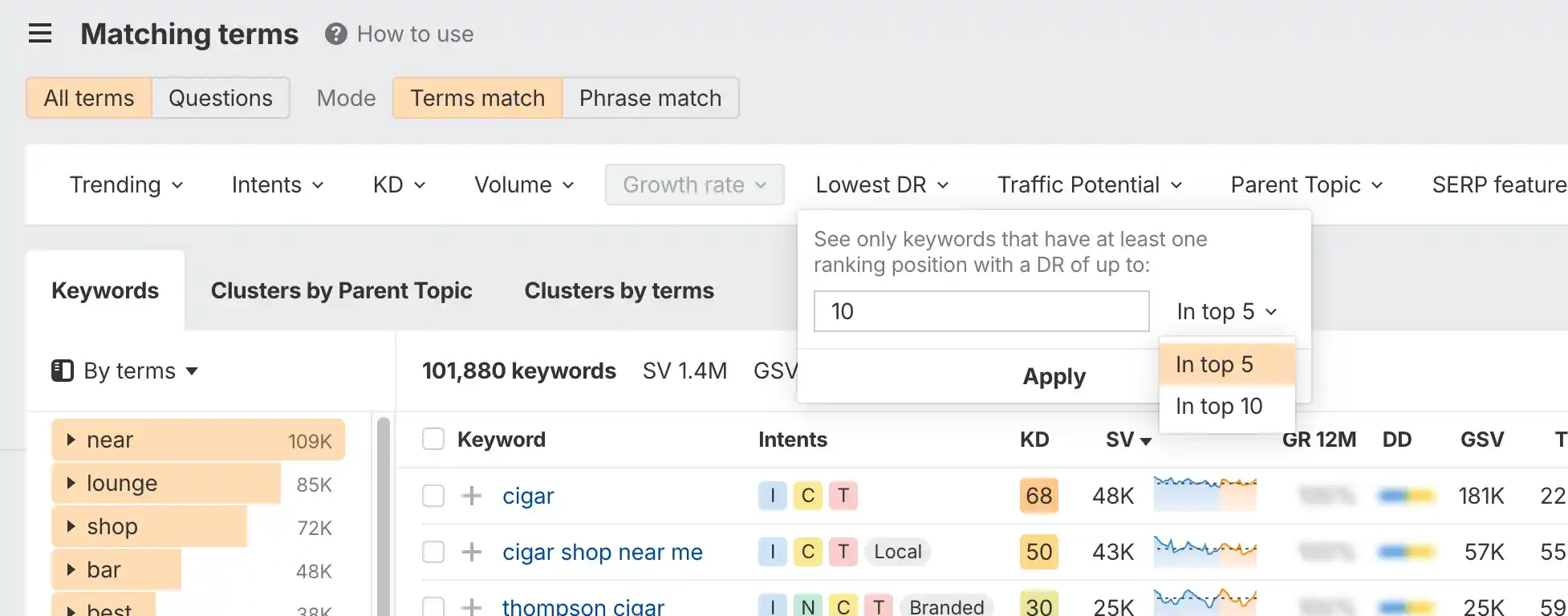
This filter is new to Ahrefs and gives you a shot at finding keywords where even low-DR sites are ranking high.
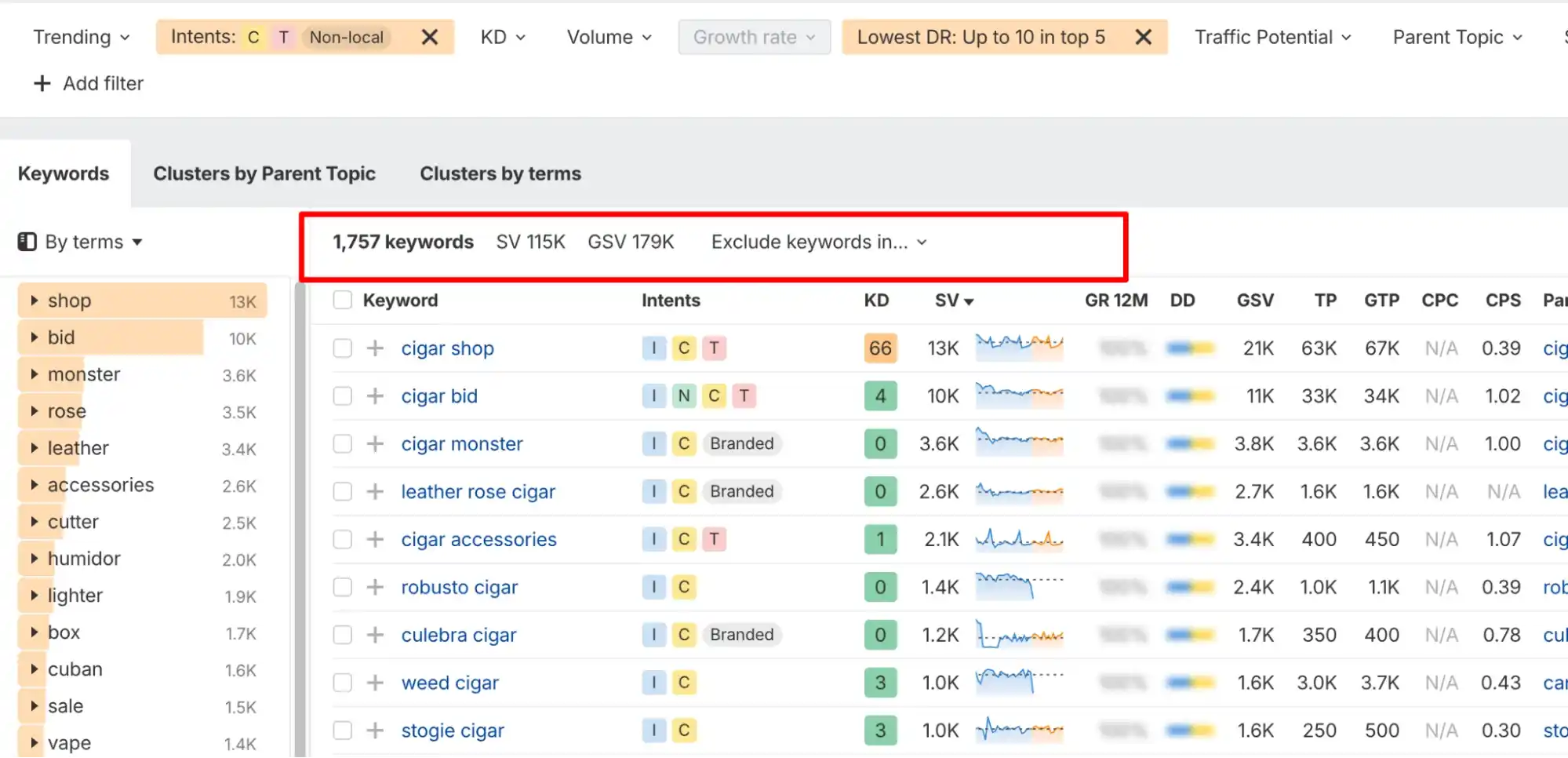
As you see, there are thousands of opportunities out there.
It helps you organize your content plans better. Not every blog post or landing page needs to go after the hardest, most searched terms. Sometimes, a few easy-to-rank-for keywords can drive traffic and conversions.
For example, instead of waiting for the keyword “white-label SEO services” to rank in the top positions.
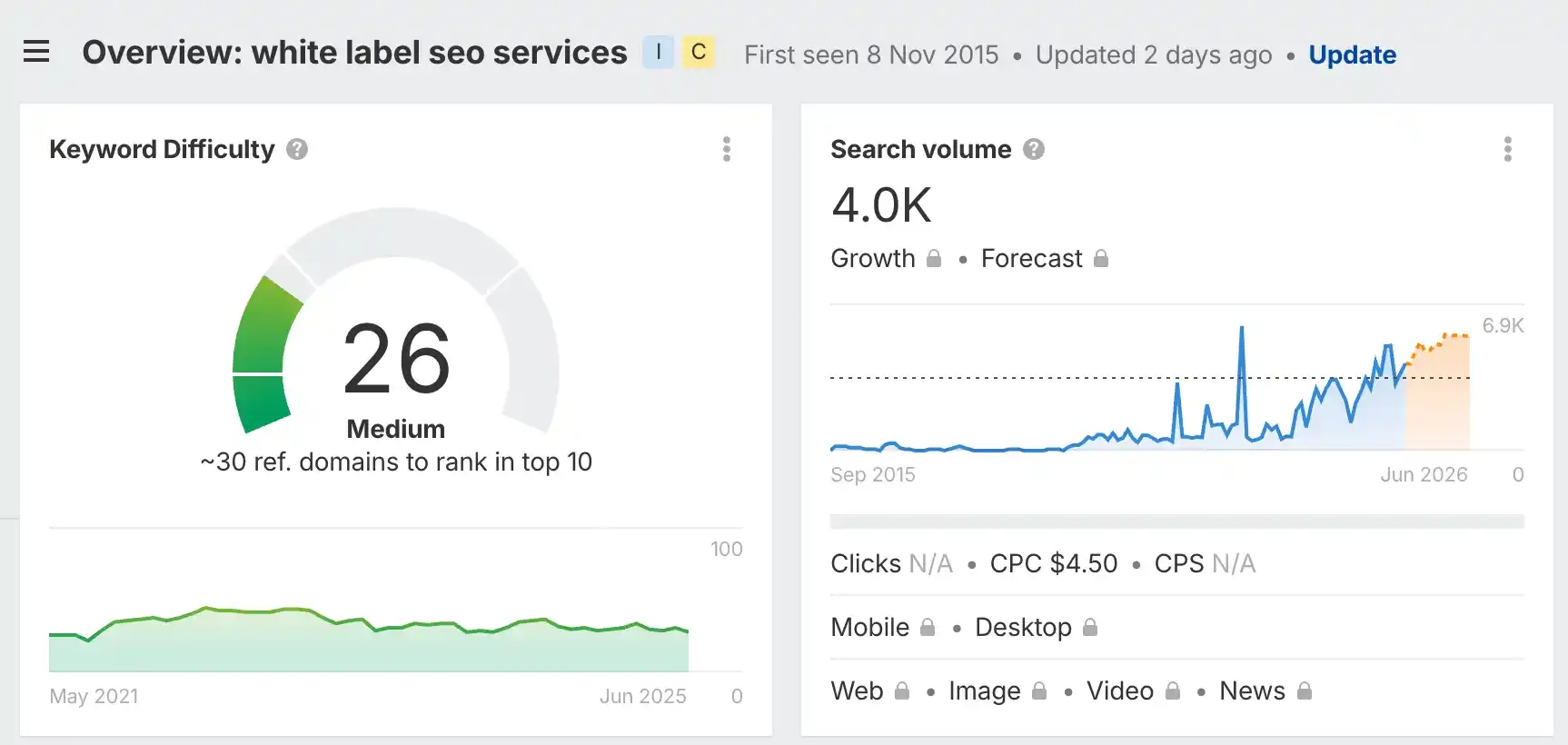
I also went after low KD ideas like “affordable SEO services” or “SEO services for B2B.” It’s not because the first keyword has a 26 KD and the second one an 8, but because the second one has better chances; I saw that after doing some manual analysis.
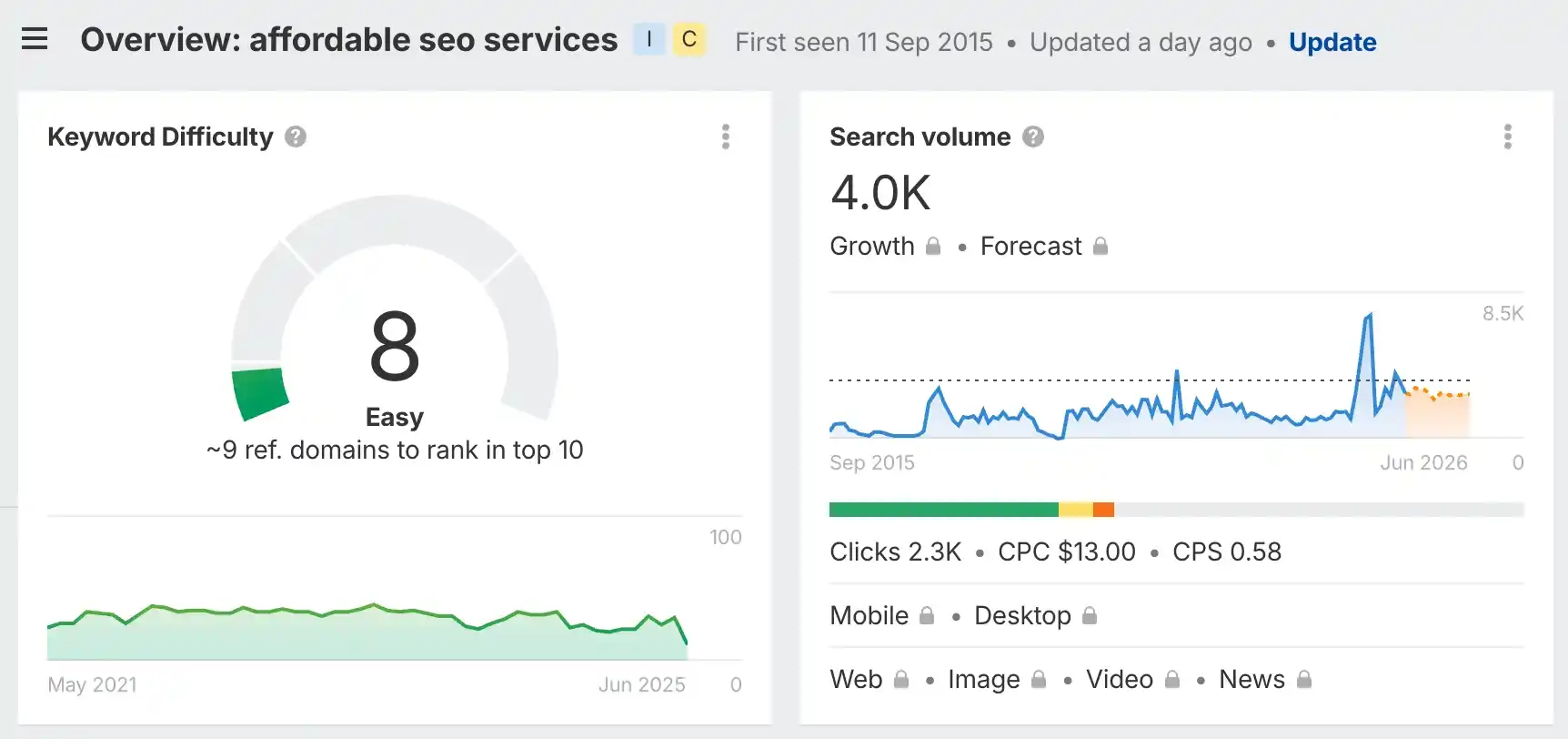
So, when you’re planning your SEO strategy, especially if you’re working with a new or small website, checking keyword difficulty helps you avoid targeting terms that are completely out of reach. Instead of wasting months trying to rank for something dominated by massive sites, you can focus on topics where you stand a chance.
In Ahrefs, a “good” Keyword Difficulty (KD) score depends on the strength of your website and how competitive your niche is. If your site is new or has fewer backlinks, target keywords with a KD below 20. As your authority grows, you can target higher-KD keywords more confidently. Always remember: KD is helpful for filtering, but it’s not the full picture; you still need to check the actual search results manually.
Yes, but it’s rare and very context-dependent. If your website has a low Domain Rating (DR), ranking for a KD 50+ keyword usually means you’re going up against strong pages with dozens (or hundreds) of referring domains. In most cases, you’ll need exceptional content, a tight match to search intent, and maybe some PR backlinks.

However, there are exceptions. If the top-ranking pages are poorly optimized, outdated, or not fully aligned with the keyword intent, a low-DR site with high-quality, well-structured, and useful content can sometimes outrank them, especially for long-tail or nuanced variations of the keyword.
As I said, Ahrefs KD gives you a rough estimate, but it’s far from the full picture. In many cases, you’ll see keywords with low KD scores (under 10) where the top results are still tough to beat because they come from massive brands with strong topical authority.
For example, the keyword “B2B SEO” has a KD of 15:
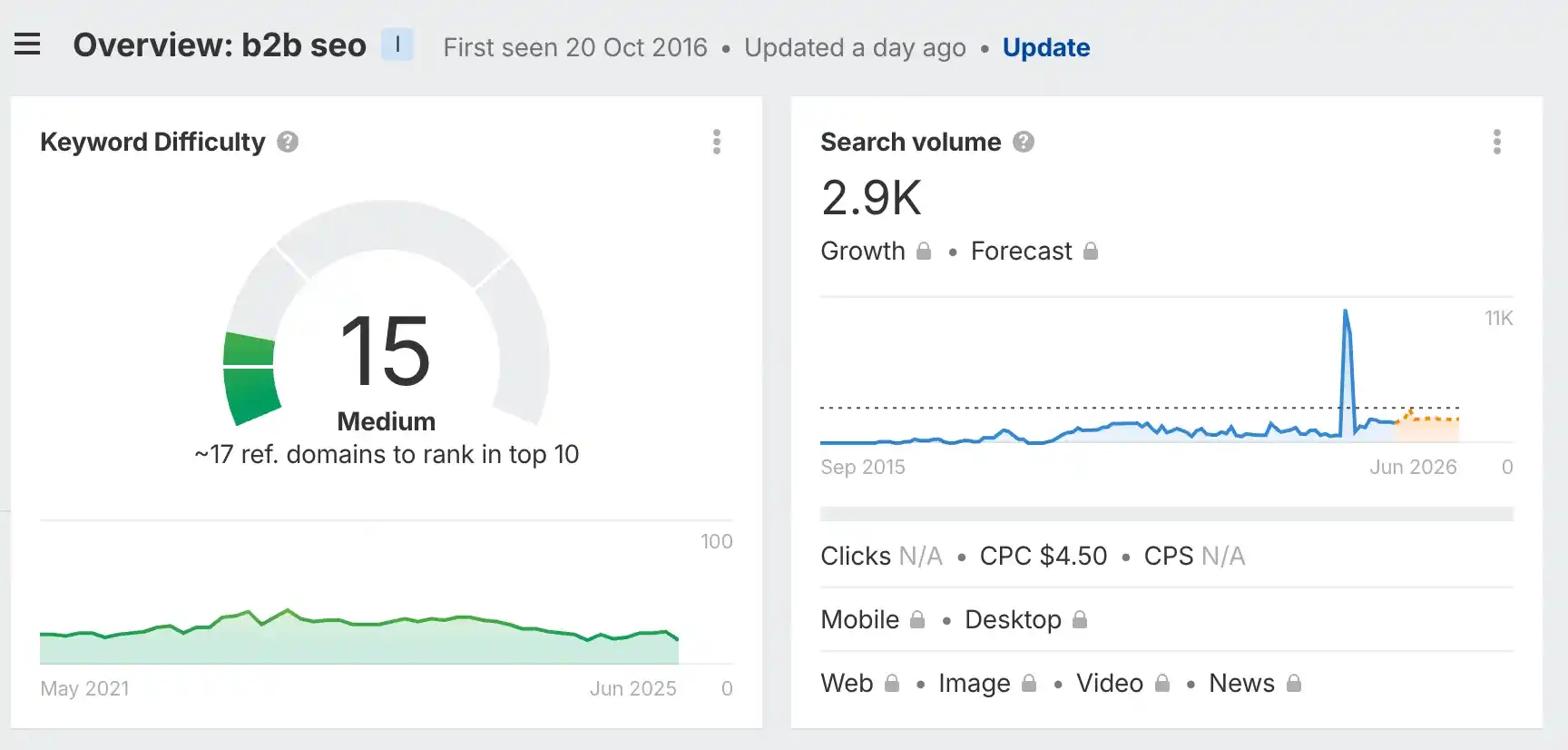
But I still have to compete with 90+ DR websites.

So, is it accurate? It’s a helpful filter, not a decision-maker. Always follow it up with a manual review of the SERP to see who’s ranking, what they’re doing right, and whether you can do better.
When Ahrefs shows “N/A” instead of a 0 KD score, it usually means the keyword doesn’t have enough data for Ahrefs to calculate a difficulty score reliably. This often happens when:
It doesn’t mean the keyword is hard or impossible; it just means the tool can’t confidently assign a score. In these cases, a manual review of the SERP is your best bet.
Yes, keyword difficulty can change based on geographic location, but most SEO tools don’t always show that nuance clearly. When tools like Ahrefs or SEMrush show keyword difficulty (KD), they usually calculate it based on the top-ranking pages in a specific country, like the US by default.
That means if you’re doing SEO in the UK, Canada, India, or any other region, the competition level might be different from what those global or US-based KD scores suggest.
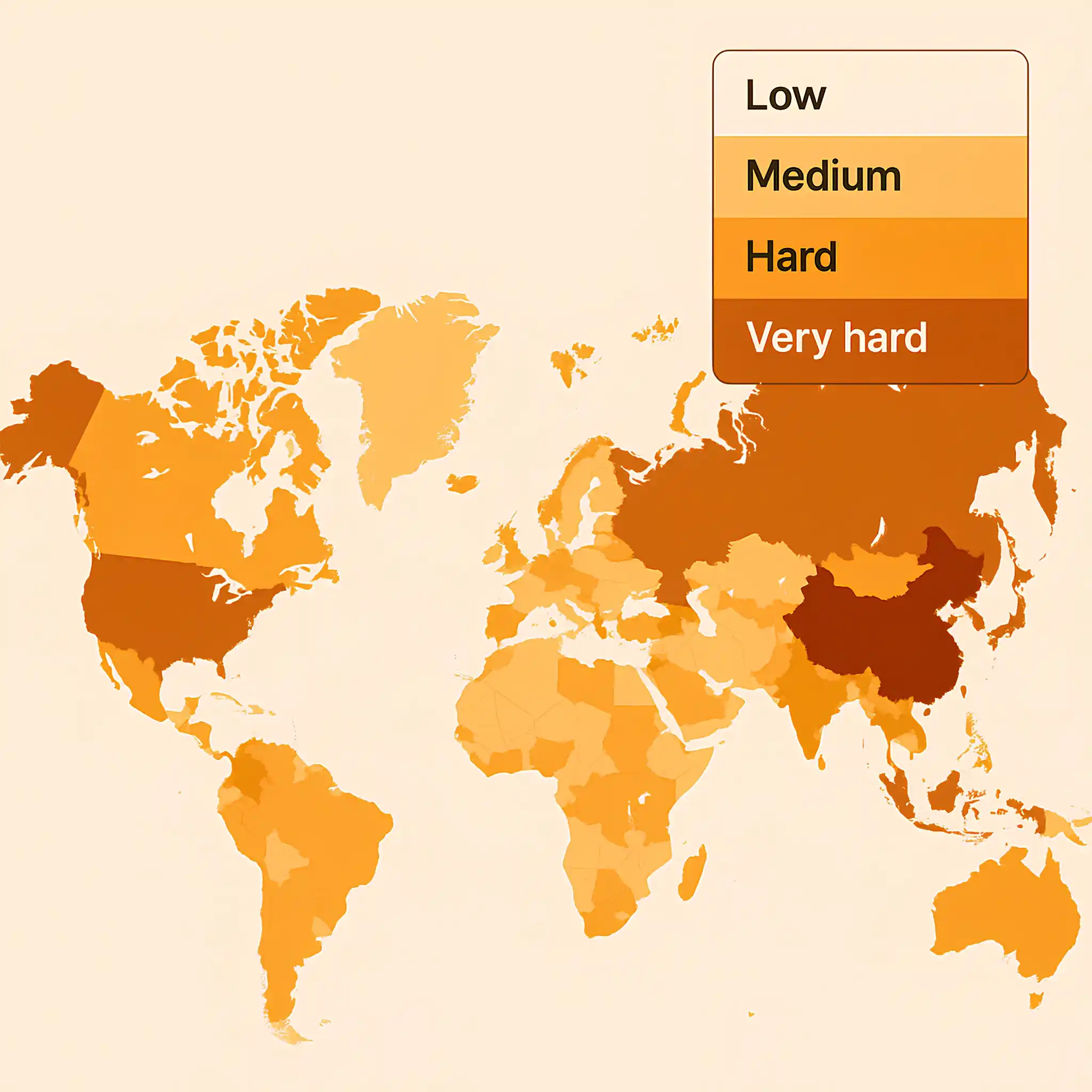
For example, a keyword that’s extremely competitive in the US might be much easier to rank for in a smaller or less saturated market.
For example, SEMrush allows you to change the region when researching keywords, and that helps.

In many cases, businesses compete within a region or city, not nationwide. If you’re targeting something like “divorce lawyer in Manchester” or “best dentist in Sydney,” the level of competition is tied to local players, not global websites.